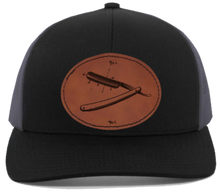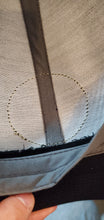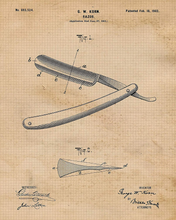Vintage straight-blade engraved Leather Patch hat, Industrially sewn on by hand to ensure the highest quality!
Adjustable size- 6 3/8 (51cm) to 8 (64cm)
Custom logos or designs are always available under our design your own engraved products, Design your own leather patch hats online here, Patches are engraved and sewn on, and patch options will be round, oval, and rectangular.
"Get Inspired" with JTM VINTAGE  ®
®
History:
By comparison to ancient tools, the modern straight razor looks like a sophisticated piece of technology. The earliest iteration of the straight razor likely came in the late 1600s and has been used for traditional manual shaving for over two hundred years. Since then, it's experienced ebbs and flows in its popularity, and in recent years has become trendy again—as part of the mortal uprising against environment-destroying and expensive plastic cartridge razors.
Early razors were basically any sharp thing anyone could get their hands. Evidenced by cave drawings from the Stone Age and ancient archaeological digs that unearthed artifacts from the middle ages and prehistoric times, the first shave began with clam shells, shark's teeth or pumice stones to scrape of facial hair. Later in ancient Egypt copper razors have been uncovered in ancient tombs.
It's unclear whether they cut their facial hair for aesthetic or pragmatic reasons; some sources say it was mostly to address vermin that would nestle into their facial hair and cause a terrible itch and rash.
Centuries later, in ancient Rome, the early versions of the straight razor were also simple tools. They used a device called the Novacila made from a block of iron with finger holes and a blade that resembled brass knuckles.
Of the different types of razors, straight razors have probably changed the least in appearance from their inception.
Part of its current appeal with wet shaving aficionados is the nostalgia of a simpler time shaving with traditional products, its simplicity and the ritual—interestingly enough it's the lack of innovation that really drives the allure of the modern straight razor.
WHAT IS A STRAIGHT RAZOR?
Modern straight razors are called open razors, straight edge razor or a cut-throat razor defined by its long exposed single blade that can be folded back into its handle.
For a long time, it was a service performed usually by a skilled barber—one of the oldest skilled trades. They were also called "Barbers Surgeons." The local Barber Surgeon was an integral part of the community and responsible for men's grooming, styling, and dressing, as well as performing surgery and dentistry. Because of their steady hands and experience, offering a shave with a razor was just evolutionarily intuitive.
Today, using straight razors at home has had made a massive resurgence in wet shaving routines. Alone, in front of the mirror, for many men, the morning shave has recently become a sacred part of the daily routine albeit a ritual, and the barbershop shave has become a luxurious premium treatment, like a day at the spa.
WHY IS IT CALLED A STRAIGHT RAZOR?
The name is fitting: The blade is one long straight edge, and it's the defining feature of the razor. It's the longest and most exposed blade available for shaving.
THE EARLY VERSIONS WERE A STATUS SYMBOL
In the late 1600s, in the early days of the modern version of the straight razor, they were a luxury good and were seen as a status symbol.
The silver steel gloss was a monumental aesthetic update, and around the same time, manufacturers began making the handles out of nicer materials—ivory and tortoiseshell among them.
In some cases, small illustrations were etched into the blade, and it was even more common for a man's initials to be engraved into the blade.
WHEN WAS THE EARLIEST STRAIGHT RAZOR MADE?
Let us start with a brief history...In 1680, a British man called John Spencer was behind an operation making "Sheffield wares" out of Sheffield, England. He was an industrialist and his company was manufacturing multiple different steel products, which included clocks and cutlery and also an early form of the straight razor.
As the straight razor evolved, the original Sheffield steel, with its characteristic deep gloss finish also known as "Sheffield silver steel" remained the the most sought after material for a blade and still is in use today by such manufacturers such as Thiers Issard a luxury straight razor brand known for its custom scales and blades.
Generations later Sheffield steel is still considered to be superior quality and the absolute best material to make the blades from because of its durability and resistance to rust, the downside because of its hardness it can be challenging to sharpen with a hone and strop.
If you are on the lookout for a vintage or antique razor the old wedge blades made of the Sheffield steel were marked with the words "cast steel" or "warranted." If you ever come across any antique straight razors and find those markings, then that razor was made in the late 1700s or early 1800s in England.







